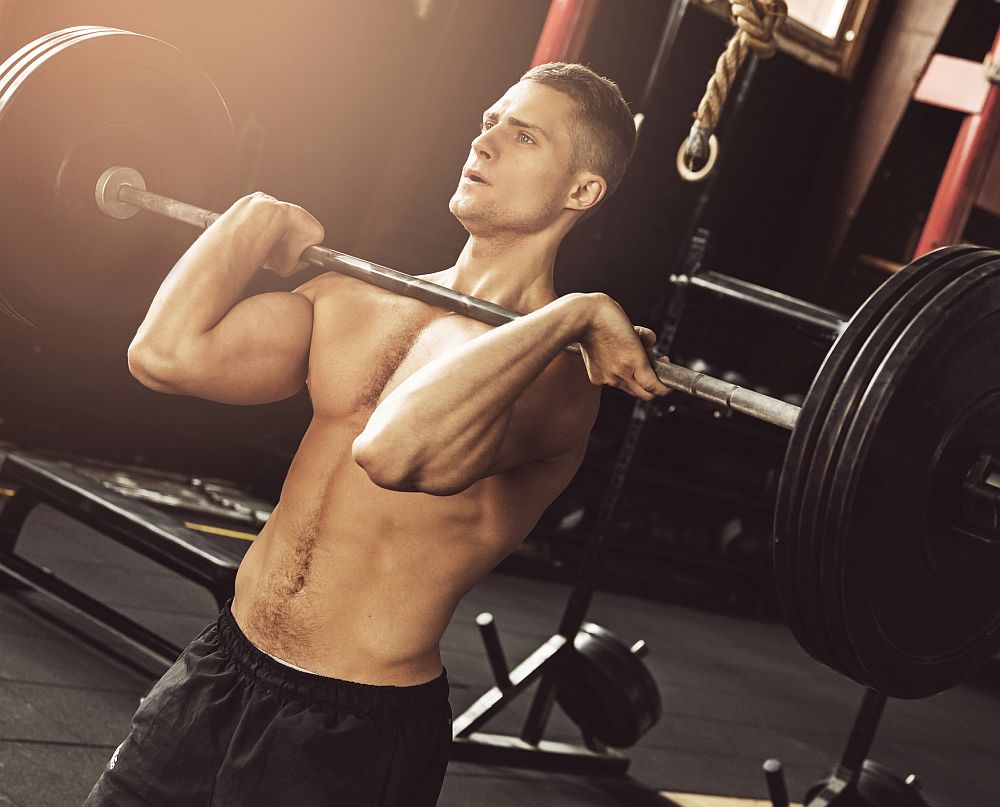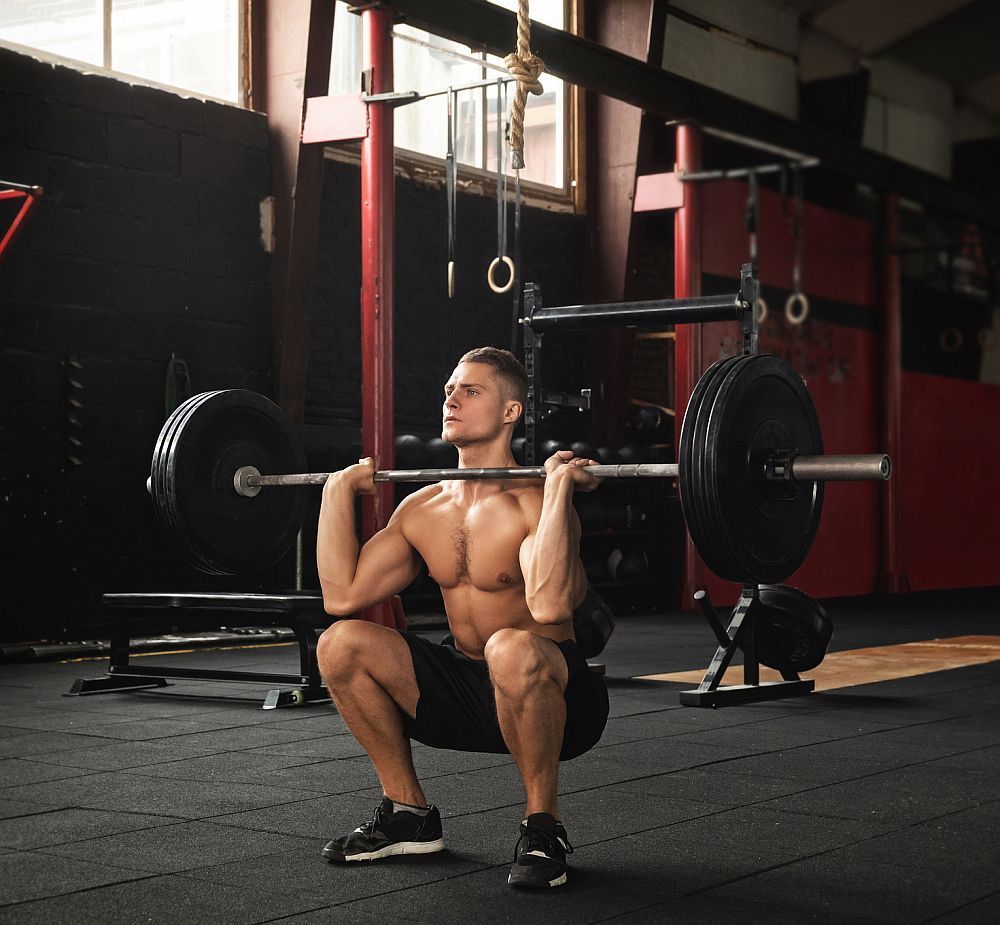The front squat is a powerful barbell squat variation for bodybuilders, weightlifters, and powerlifters alike. This squat variation is ideal for those looking to shift the focus to building powerful quads or pushing for a PR increase in their Olympic cleans.
The problem? Finding the right grip to hold the bar safely throughout the movement.
Here’s what you need to know about front squat grip variations and how to hold the bar to prevent injury.

Explore the topic
Front Squat 101
The barbell front squat is a foundational lift frequently performed in Olympic weightlifting training and CrossFit. With this squat variation, the lifter holds the barbell in a front rack position, resting across the chest rather than the back. This positioning shifts the onus of the movement to the quads, whereas back squats primarily target the hamstrings and glutes. While all of the lower body and core muscles are engaged in both front and back squats, the primary movers shift.
One of the main challenges people face when trying the front squat is wrist flexibility. To hold the bar in the front rack position, you need decent wrist mobility so you can reach back and place your fingers under the bar in the traditional position. While it seems silly to complain about having big muscles, you may struggle despite having good wrist flexibility if you have big shoulders and biceps. Poor you with your big muscles.
Let’s dive into the three primary front squat grip variations and how you can determine which one is right for your body.
Front Squat Grip One: Traditional Front Rack

The traditional front rack position will have your hands placed slightly outside of shoulder-width, with the bar resting across your anterior deltoids (the front of your shoulders). Your fingers will be hooked under the bar for stability. Depending on your wrist mobility, you may only be able to hook a few fingers under the bar.
The benefit of the traditional front rack position (sometimes called the clean grip) is that you can self-coach yourself throughout the movement. Many people who hit the heavier weights with front squats tip forward, leading with the hips rather than the chest to ascend back to the starting position. It’s easy to notice this issue and self-correct based on your elbow position; they should stay raised and pointed ahead throughout the movement. If you notice your elbows tipping forward, pull them up.
As mentioned, this starting position is difficult for those with a lack of wrist mobility. It can even cause lasting wrist pain for those who force the position. As a lifter, you can adjust to a slightly wider grip to make up for the mobility issues, but pushing it too far can put undue stress on the shoulder joint. That’s where the alternative grips come in.
Front Squat Grip Two: Cross Grip Front Rack

The first elbow position variation is the cross grip. Rather than keeping your elbows in a forward-facing position, you place the barbell across your front deltoids and cross your arms to hold the bar in place. Your right hand will rest on your left side, and your left hand will rest on your right side.
This grip variation is beneficial for those with a large upper body or poor upper body flexibility. It makes this lift more accessible for those who are physically unable to get into a clean grip position. If you’re doing front squats in this position with a lighter weight, it can help you build core strength.
However, the cross arm grip requires a lot of upper body strength to maintain proper form and a stable position throughout the movement. The slight shift in arm positioning creates anterior instability. As you get up to a heavy weight, you’ll notice the bar try to pull your back into a rounded position as you come out of the bottom of your squat. You’ll need to be more mindful of back engagement and may not be able to do heavier weights with the cross grip. Furthermore, this shift also exhausts your upper body muscles faster, limiting your potential.
Front Squat Grip Three: Strap-Assisted Grip

The third front squat grip variation is the strap-assisted grip. The lifter places straps around the bar just outside shoulder-width with this variation, then holds the straps slightly above the bar while maintaining tension. The elbows are positioned forward in the same manner as the standard grip.
The overarching benefit of this variation is that it puts the body in a proper squat stance, making it easier to keep a vertical torso throughout the movement. It also allows for people with limited mobility to get into a traditional— if modified— front rack position.
There are three notable issues with using straps. First, if your goal is to perform Olympic lifts— the snatch and the clean and jerk— you’ll be unable to do so with straps. Additionally, you’re compensating for a poor level of mobility rather than working on improvements.
Finally, and perhaps most importantly, straps can be a safety issue. Never wrap the straps around your hands! If you get tired and need to bail, you must be able to let go of the bar and step back. Wrapping the straps puts you at risk of hurting yourself.
Front Squat Grips – FAQs
Front squats are a complex movement. Here are some commonly asked questions about doing front squats and how they compare to other squat movement variations.

Why do front rack holds?
Front rack holds challenge you to hold massive weights (typically above your 1RM) in a front rack position without squatting. This teaches you to keep your core tight and your chest upright. International athletes in the Olympics typically use this accessory move to teach proper squat technique.
How do I get a good front rack position?
Practice and dedication to improving your wrist and arm mobility. It also helps to improve ankle mobility to prevent tipping forward during the movement.
Why are front squats so hard?
Front squats put the barbell in an unstable position which requires extra strength, mobility, and stability to complete.
Are front squats worth doing?
It’s worth training your body in the front squat position. However, unless your goal is to do Olympic weightlifting or CrossFit competitions, there’s no need to load massive weights. You can train the same position with dumbbells or kettlebells.
Do front squats work abs?
Front squats engage your abdominal muscles in a powerful way. Doing this compound exercise will help you build a strong core, but it won’t build defined abs (which are just for show).
Why are front squats better for athletes?
Front squats have a better transfer to sports movements than back squats, based on the positioning of the body. This squat position puts less stress on the spine and better replicates the positions many athletes find themselves in.
How to Choose the Best Front Squat Grip
Choosing the best front squat grip ultimately depends on your goals and mobility.
However, it’s worth spending time improving your wrist mobility to get into the standard position. If you opt for the crossed arm grip, stick with lighter weights and focus on proper technique.
With time and practice, you can perfect your front squat form and grip.